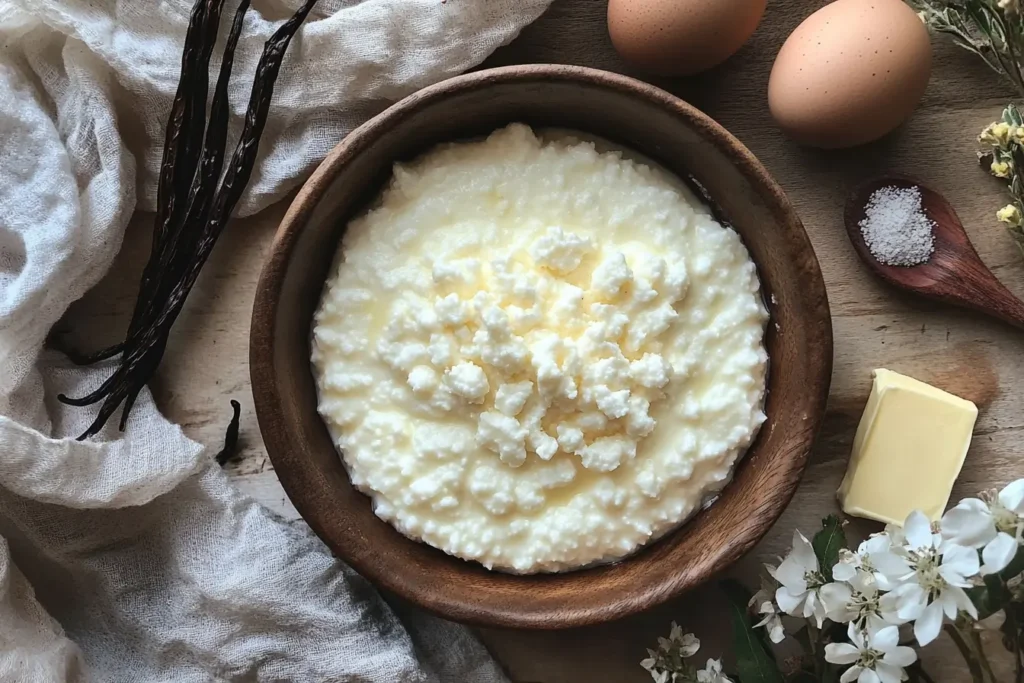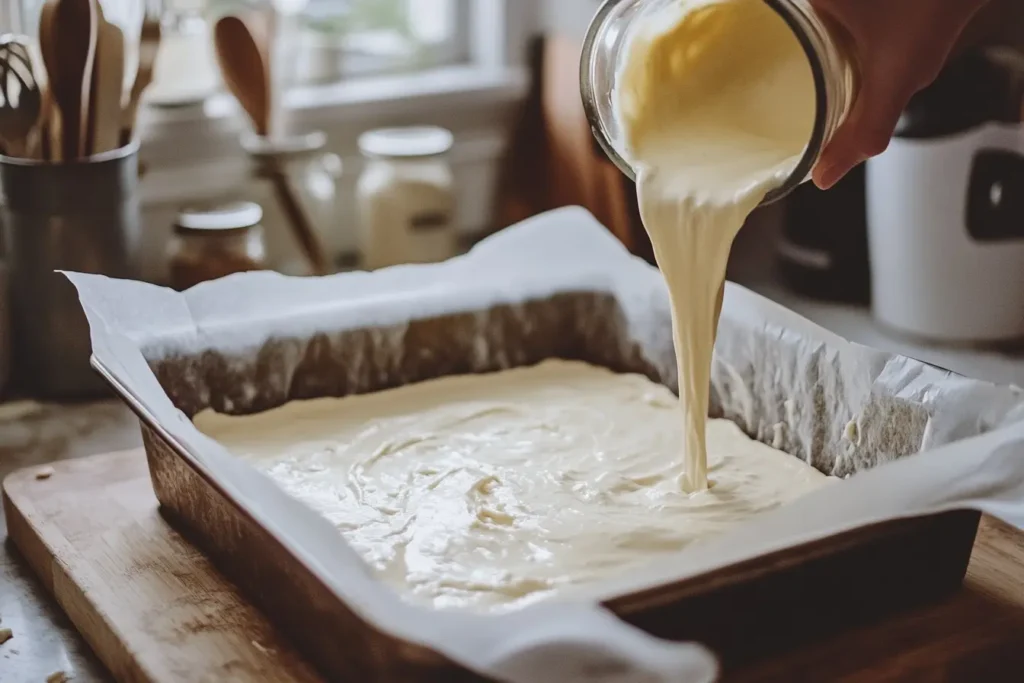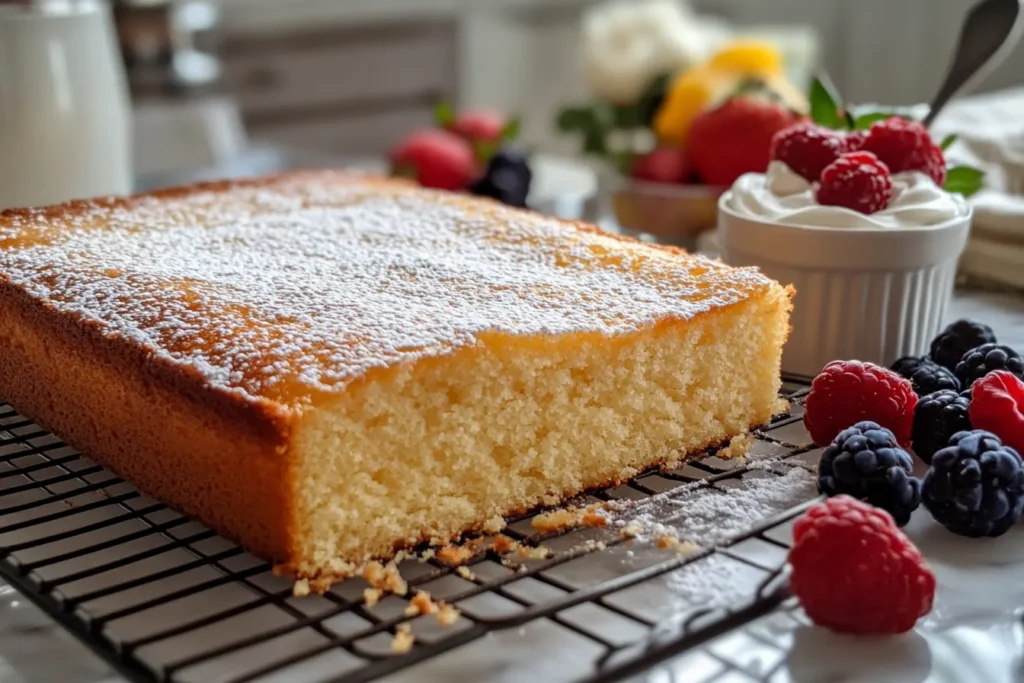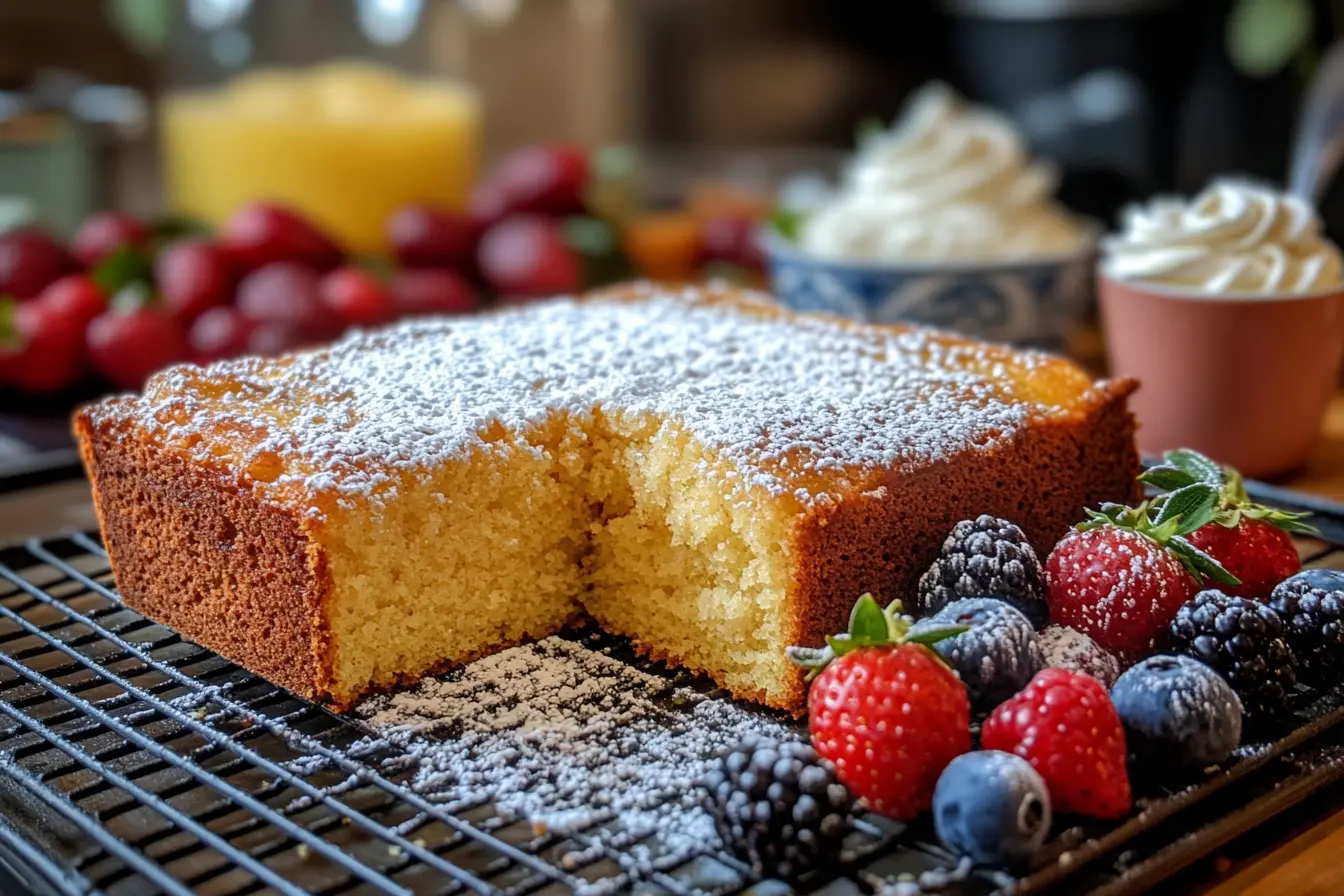Introduction: Mastering the Art of Kefir Sheet Cake
Crafting a kefir sheet cake goes beyond the act of baking; it takes you on a delightful journey where tradition blends seamlessly with innovation. Because it is rich in probiotics, kefir turns an ordinary cake into a moist, tangy, and completely irresistible treat. This guide takes you step-by-step through the process, offering clear instructions, essential ingredients, expert techniques, creative variations, and helpful FAQs to ensure success at every stage. Moreover, by following these tips, you can easily create a cake that’s both delicious and uniquely nutritious. Whether you’re a seasoned baker or just starting, this guide ensures your kefir sheet cake recipe card becomes a cherished staple.
Discover the Delight of Kefir Sheet Cake
What Makes Kefir Sheet Cake Unique?
Kefir sheet cake stands out because of its probiotic-rich kefir, a fermented milk product known for its tangy taste and creamy texture. The inclusion of kefir not only creates a fluffy, moist crumb but also adds a subtle tartness, elevating the flavor profile of the cake. Unlike traditional cakes, kefir sheet cakes boast health benefits due to the live cultures found in kefir.
A Brief History of Kefir in Baking
Although kefir originates from the Caucasus Mountains, it has traveled far and wide, finding a home in kitchens across the globe. Its use in baking has grown, blending old-world traditions with modern culinary trends. In recipes like sheet cakes, kefir replaces traditional dairy products such as buttermilk or yogurt, making it a versatile choice for bakers seeking a unique twist.
Why You Should Try a Kefir Sheet Cake
There’s no shortage of reasons to experiment with a kefir sheet cake recipe card:
- Texture Perfection: The natural acidity in kefir activates baking soda, ensuring a tender and airy texture.
- Flavor Versatility: From adding fresh fruits to integrating spices, kefir sheet cakes are highly adaptable.
- Nutritional Benefits: Packed with gut-friendly probiotics, this cake offers a guilt-free indulgence.
Link to the Health Benefits of Kefir
To delve deeper into the probiotic advantages of kefir, explore this Health Benefits of Kefir guide. It sheds light on why kefir is a powerhouse ingredient in your baking arsenal.
Essential Ingredients and Preparation
Essential Ingredients for Kefir Sheet Cake

Every masterpiece begins with the right materials, and a kefir sheet cake recipe card is no exception. Here’s what you’ll need to craft this delightful treat:
- Kefir: The star of the show. Use plain, unsweetened kefir for a balanced tang.
- All-purpose flour: Provides structure and ensures the cake holds its shape.
- Sugar: White or light brown sugar works well for a subtle sweetness.
- Eggs: Bind the ingredients and contribute to the cake’s richness.
- Butter or oil: For that soft and moist crumb.
- Baking soda: Reacts with the acidity of kefir to create a light, fluffy texture.
- Vanilla extract: Adds a hint of aromatic sweetness.
- Optional Add-ins: Think chocolate chips, nuts, or dried fruits for a unique twist.
Selecting the Right Kefir for Baking
The choice of kefir significantly impacts the final cake. Here’s how to select the best option:
- Consistency: A thicker kefir produces a denser cake, while thinner kefir yields a lighter texture.
- Flavor: Plain kefir is ideal, but lightly flavored versions (e.g., vanilla) can add depth. Avoid overly sweetened or fruit-laden kefirs.
- Homemade vs. Store-bought: Homemade kefir often has a stronger tang, while store-bought varieties are more consistent.

Step-by-Step Preparation Guide
Here’s how to transform these ingredients into a delectable kefir sheet cake:
- Preheat the Oven: Set your oven to 350°F (175°C). Grease a rectangular baking pan or line it with parchment paper for easy cleanup.
- Mix the Dry Ingredients: In a large bowl, combine flour, sugar, baking soda, and a pinch of salt. Whisk to evenly distribute the dry components.
- Prepare the Wet Ingredients: In a separate bowl, whisk kefir, eggs, melted butter (or oil), and vanilla extract until smooth.
- Combine Wet and Dry Mixtures: Gradually add the wet ingredients to the dry mix, stirring gently to avoid overmixing. Overmixing can lead to a dense cake.
- Add Optional Ingredients: Fold in chocolate chips, nuts, or your preferred add-ins for extra flavor.
- Pour into the Pan: Spread the batter evenly in the prepared pan.
- Bake: Place the pan in the oven and bake for 30–40 minutes, or until a toothpick inserted in the center comes out clean.
- Cool and Decorate: Let the cake cool before frosting or serving plain.
In the following segment, we’ll explore advanced baking techniques, troubleshooting tips, and how to achieve the perfect flavor balance in your kefir sheet cake.
Baking Techniques and Tips
Baking the Perfect Kefir Sheet Cake
Achieving the perfect kefir sheet cake isn’t just about following a recipe—it’s about understanding the finer details of baking. Here are key techniques to ensure your cake turns out flawless:
- Room Temperature Ingredients: Allow your eggs and kefir to reach room temperature before mixing. This promotes better incorporation and a smoother batter.
- Sift Dry Ingredients: Sifting the flour and baking soda removes lumps and creates a lighter texture.
- Avoid Overmixing: Stir the batter just until combined. Overmixing can develop gluten, leading to a tougher cake.
- Monitor Baking Time: Ovens can vary, so start checking your cake 5 minutes before the suggested baking time. Use a toothpick to test doneness.
- Cool Gradually: After baking, let the cake rest in the pan for 10 minutes before transferring it to a wire rack. This prevents cracking.
Common Mistakes to Avoid
Even seasoned bakers can stumble upon a few pitfalls. Here’s how to sidestep them:
- Skipping the Preheat: An improperly preheated oven can result in uneven baking or a sunken center.
- Using the Wrong Pan: A sheet cake thrives in a flat rectangular pan. A pan that’s too deep might alter baking time and consistency.
- Ignoring Measurements: Baking is a science—imprecise measurements can throw off the balance of ingredients.
Enhancing Flavor with Add-ins
While a classic kefir sheet cake is divine, adding a personal touch can elevate it further:
- Fresh Fruits: Blueberries or diced apples can add bursts of flavor.
- Spices: A hint of cinnamon, nutmeg, or cardamom pairs beautifully with kefir’s tanginess.
- Zests and Extracts: Lemon zest or almond extract introduces a delightful aroma and complexity.

In the succeeding section, we’ll uncover exciting variations of the classic kefir sheet cake and present unique serving ideas tailored to every occasion.
Serving Suggestions and Variations
Creative Variations of Kefir Sheet Cake
A kefir sheet cake recipe card isn’t set in stone—its versatility allows you to experiment with flavors, textures, and themes. Here are some creative takes:
- Chocolate Kefir Sheet Cake: Add cocoa powder to the batter and top with chocolate ganache for a rich, indulgent twist.
- Citrus Delight: Incorporate lemon or orange zest into the batter, and finish with a tangy glaze.
- Nutty Bliss: Fold in chopped walnuts, pecans, or almonds for added crunch and flavor.
- Seasonal Specialties: Infuse pumpkin puree and spices for a fall-themed treat or fresh berries for a summery vibe.
Tip: Layer the sheet cake with whipped cream and fruit compote to turn it into a stunning layered dessert.
Serving Ideas for Different Occasions
The beauty of a kefir sheet cake lies in its adaptability to any gathering or meal. Here’s how you can tailor it:
- Casual Brunches: Serve plain or with a dusting of powdered sugar alongside coffee or tea.
- Celebratory Events: Frost with cream cheese or buttercream and decorate with sprinkles, fresh fruits, or edible flowers.
- Family Dinners: Pair warm slices with a dollop of vanilla ice cream for a comforting dessert.
Storing and Preserving Your Cake
Proper storage keeps your kefir sheet cake moist and flavorful for days. Follow these tips:
- Room Temperature: Store in an airtight container for up to two days.
- Refrigeration: For longer storage, cover tightly and refrigerate for up to a week. Bring to room temperature before serving.
- Freezing: Wrap individual slices in plastic wrap, then foil, and freeze for up to three months. Thaw overnight in the refrigerator.
Continuing in the following part, we’ll address frequently asked questions to ensure all your doubts about kefir sheet cakes are covered comprehensively.
Frequently Asked Questions about Kefir Sheet Cake
Can I Substitute Buttermilk for Kefir?
Yes, you can substitute buttermilk for kefir in most baking recipes, including a kefir sheet cake. However, keep in mind that kefir has a slightly tangier flavor and a thicker consistency, which can impact the cake’s texture and taste. If using buttermilk, consider reducing other liquids slightly or adding a spoonful of yogurt to mimic kefir’s consistency.
How Do I Make a Gluten-Free Version?
Creating a gluten-free kefir sheet cake is simple with a few tweaks:
- Flour Substitute: Use a high-quality gluten-free baking flour blend that includes xanthan gum or guar gum for structure.
- Kefir Consistency: Ensure the batter isn’t too runny; gluten-free flours often absorb liquids differently. Add a tablespoon of cornstarch if needed.
- Baking Time: Gluten-free cakes sometimes require slightly longer baking times. Check for doneness with a toothpick.
What Toppings Complement Kefir Sheet Cake?
The beauty of a kefir sheet cake is its ability to pair with a wide variety of toppings:
- Classic Frosting: Cream cheese frosting or a simple vanilla glaze works wonders.
- Whipped Toppings: Lightly sweetened whipped cream adds an airy, delicate finish.
- Fruit Compote: Warm berry or apple compote enhances the tanginess of the cake.
- Crunchy Additions: Sprinkle with toasted nuts or coconut flakes for added texture.
How Long Does the Cake Stay Fresh?
Stored properly, a kefir sheet cake remains fresh for:
- Room Temperature: 2 days when kept in an airtight container.
- Refrigerator: Up to 7 days, tightly covered.
- Freezer: Up to 3 months when wrapped securely in plastic and foil.
For optimal freshness, bring refrigerated or frozen cake to room temperature before serving.
Can I Use Flavored Kefir?
Flavored kefir adds an exciting and easy way to customize your cake, making it uniquely yours. Vanilla or fruit-flavored kefir introduces a delightful twist to the batter, enhancing the overall taste without requiring additional extracts or flavorings. Furthermore, these subtle flavors blend seamlessly into the cake, complementing its tangy undertones. While experimenting with flavored kefir, ensure it doesn’t contain excess sugar, as it could alter the sweetness or texture of your final bake.. However, avoid kefir with added sugars, as it may alter the cake’s sweetness and moisture levels.

